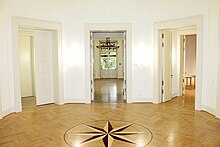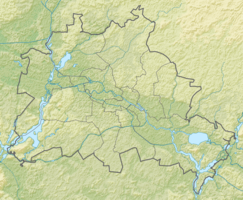Biesdorf Castle
| Biesdorf Castle | ||
|---|---|---|
 |
||
| Data | ||
| place | Berlin-Biesdorf | |
| architect | Heino Schmieden , Martin Gropius | |
| Architectural style | Late classical plastered building with a T-shaped floor plan | |
| Construction year | 1868 | |
| Coordinates | 52 ° 30 '35.2 " N , 13 ° 33' 27.7" E | |
|
|
||
The Biesdorf castle , a building built in 1868, stands in the Castle Park Biesdorf the Berlin district in Biesdorf in Marzahn-Hellersdorf . Today it is the district's municipal gallery and a venue for cultural events.
history
Construction and architecture
In 1827 the Prussian state sold Gut Biesdorf, which led to several changes of ownership. In 1853, Hans-Brunno von Rüxleben bought the estate for 45,000 thalers . His son Hans-Hermann Freiherr von Rüxleben inherited the Biesdorf property from his father in 1862. After marrying Anne Pauline Griebenow on May 3, 1868, he bought six adjoining farms and four farms.
1868–1869 an Italian tower villa was built northeast of the Biesdorfer Dorfanger and a four- hectare park was created. The villa was created according to plans by the architect Heino Schmieden . The landscape architects Eduard Neide and Albert Brodersen designed the park .
“Biesdorf Palace is next to the Charlottenburg, Bellevue, Schönhausen, Köpenick, Glienicke and Friedrichsfelde palaces - to name just a few - a gem in the Berlin monument landscape. You have to know that there are only about 25 castles, manors and palaces in Berlin. Restored in convincing beauty, the palace and park represent an indispensable source of local history in terms of building and gardening, social and cultural history. "
There are no construction plans for the building. The villa is a building in the Italian late classical style on a T-shaped floor plan . The plastered building initially had two floors on a high basement. A pillared vestibule forms a covered approach in front of the western main entrance. On the south and east sides, loggias and pergolas adorned with columns loosen up the building. The tower on the southeast corner on an octagonal floor plan is striking . It ends with an open colonnade ( called Belvedere ) on which a copper helmet sits. The facade design in colored Roman cement mortar (artificial stone facade , executed by the Berlin master plasterer H. Beyerhaus as "my first facade in cement") is considered to be a special protection item, which is unique for the Berlin area .
Siemens villa
The merchant Günther von Bültzingslöwen acquired the Biesdorf estate and manor house in 1887, but had to sell it again because he made great losses during the sugar crisis . Werner Siemens , who had been friends with him since his school days, initially gave Bültzingslöwen a loan of 200,000 marks and finally took over the approximately 600 hectare property on February 17, 1887. Because he was not interested in the villa, he transferred it to his son Wilhelm von Siemens in 1889 . Between 1888 and 1889, Wilhelm von Siemens arranged the necessary repairs by making two minor structural changes. The construction work was carried out by the architect Theodor Astfalck . The southern loggia and the balcony were widened, and a curved flight of stairs was created on the eastern loggia facing the park . The building got a new coat of paint. By 1927, the Siemens family had developed the castle and park that became known as the Siemens Villa .
City of Berlin
On October 27, 1927, the city of Berlin acquired the 380 hectare property with villa and park. The police moved into the lower service rooms. In 1929 the Biesdorf local office was set up and four years later the local branch of the NSDAP and NSV moved in . The castle burned on 20./21. April 1945 completely - whether it was arson or a bombing is not known. The first necessary security measures began immediately after the end of the Second World War . A celebration hall was set up in the great hall for the fallen members of the Soviet army and the offices were expanded. In the case of further structural changes, the room heights on the ground floor were reduced by inserting a false ceiling. Window openings that now overlapped with the renovations and some skylights were bricked up. The plaster facades with their architectural structures made of extremely high -quality artificial stone - like colored plaster have been better preserved until the renovation in 2013 than the repair mortar from the years after 1946. Before 2016, the former zinc cast parapets of the balconies and loggias could only be seen on the tower balcony, the earlier interior design got completely lost. In the early 1960s the castle served as a village club. In the mid-1970s, it was converted into a cultural center and the park was refreshed. A branch of the Marzahn district library was located in the castle. The palace has been on the Berlin list of monuments since 1979. After the political change came the end of the cultural center.
Restoration and reconstruction
It was only after 1990, when the city of Berlin took more care of the palace again and the Association for the East-West Encounter Foundation of Schloss Biesdorf was founded, that the palace and park gradually regained their historical appearance. In 2000, the initiative for the rescue of Biesdorf Castle, called for construction work and donations in kind of around 154,000 marks (adjusted for purchasing power in today's currency: around 104,000 euros) from sponsors . At least 8.5 million euros were budgeted for the complete reconstruction.
Between 2002 and 2007, the palace facade was renovated and reconstructed in accordance with historical monuments for around 1.75 million euros with funding from the Deutsche Klassenlotterie Foundation , the Berlin State Monuments Office, the German Monument Protection Foundation , the Marzahn-Hellersdorf district and numerous private sponsors . The Office for Architecture, Urban Development and Monument Preservation (BASD) Berlin took on the planning and construction management; The project manager was the architect Raphael Abrell.
On March 29, 2007, the Lottery Foundation announced that it would contribute 4.75 million euros for the reconstruction of the upper floor. The remaining 3.75 million euros came as funding from the European Union. The construction work began with the farewell on the way to the picture castle on September 8, 2013, the 100th anniversary of Heino Schmieden's death . The securing work under the leadership of the architect Pinardi and the company PMS continued until the topping-out ceremony on December 12, 2014. The complete reconstruction of the former manor house under the responsibility of the client, the Marzahn-Hellersdorf district, lasted until 2016.
Art and culture in Biesdorf Castle

The building ensemble was opened on September 9, 2016 as the center for art and public space Schloss Biesdorf (ZKR) by the Governing Mayor of Berlin , Michael Müller . As a cultural project of the state-owned Grün Berlin GmbH , the ZKR dedicated its program to the interplay of art, architecture and public space. Changing exhibitions presented international contemporary art together with art in the GDR until April 2018. Since February 2018, the castle has again been run under the direction of the culture department of the Marzahn-Hellersdorf district. The municipal gallery Schloss Biesdorf under the artistic direction of Karin Scheel shows changing thematic exhibitions with positions of contemporary art and cultural heritage, often with a focus on urban space. An important cooperation partner is the Beeskow art archive with its holdings of around 23,000 objects (mainly paintings, prints, drawings and watercolors) from the GDR. The gallery in the castle maintains close cooperation with these and other partners from art and culture.
The in-house M laboratory offers an extensive accompanying program . Works by Martin Kippenberger , Manfred Paul, Sighard Gille , Sabina Grzimek , Stefan Roloff , Wolf Vostell and others have already been shown . a.
There is also a café in the castle.
literature
- Josef Batzhuber: Biesdorf Palace and Park, Marzahn-Hellersdorf district. In: Bund Heimat und Umwelt in Deutschland (Ed.): White paper on historical gardens and parks in the new federal states. 2nd edition, Bonn 2005, ISBN 3-925374-69-8 , pp. 29–31.
- Folkwin Wendland: Berlin's gardens and parks from the founding of the city to the end of the nineteenth century. (= Classic Berlin ). Propylaeen, Berlin 1979, ISBN 3-549-06645-7 , p. 337 f.
- Bernd Maether: Schloss Biesdorf: [history, timetable, travel information]. Homilius, Berlin 2002, ISBN 3-931121-41-0 , p. 26.
Web links
- Entry in the Berlin State Monument List Schloss Biesdorf
- Entry in the Berlin State Monument List: Palace Park
- Home page. In: schlossbiesdorf.de. (official website).
- - FRIENDS SCHLOSS BIESDORF e. V. In: freunde-schloss-biesdorf.de. (Foundation Schloss Biesdorf e.V.).
- Biesdorf Castle Park in Marzahn-Hellersdorf - #MaHe. In: mahe.berlin. Archived from the original on March 28, 2019 .
- Biesdorfer Parkbühne »Biesdorfer Parkbühne. In: biesdorfer-parkbuehne.de.
- Concept for the cultural use of Biesdorf Castle. In: Kultur-projekte.de.
Individual evidence
- ↑ 150 years of Biesdorf Castle. (PDF; 138 kB) In: schlossbiesdorf.de. May 11, 2018, accessed September 11, 2018 .
- ↑ Institute for Monument Preservation (Ed.): The architectural and art monuments of the GDR. Capital Berlin-II . Henschelverlag, Berlin 1984, p. 250 f .
- ↑ Werner von Siemens: Memoirs
- ^ Foundation East-West Meeting Place Schloss Biesdorf e. V. In: archiv.stiftung-schloss-biesdorf.de. Retrieved June 4, 2020 .
- ^ Oleg Peters: Heino Schmieden: Life and work of the architect and builder 1835-1913 . Lukas Verlag, Berlin 2016, ISBN 978-3-86732-169-3 , pp. 81, 85, 421.
- ↑ Biesdorf Castle cultural monument
- ↑ The castle before the fire (photo)
- ↑ Schloss Biesdorf gets an upper floor again - Berliner Morgenpost. In: morgenpost.de. March 29, 2007, accessed June 4, 2020 .
- ^ Friends of Biesdorf Castle e. V. In: freunde-schloss-biesdorf.de. Retrieved June 4, 2020 .
- ^ Biesdorf Castle. In: ensembleschlossbiesdorf.wordpress.com. Retrieved June 4, 2020 .
- ↑ Senate Department for Urban Development has approved the preliminary planning documents for Biesdorf Castle - Berlin.de. In: berlin.de. March 14, 2013, accessed June 4, 2020 .
- ^ Archive of the ZKR Castle Biesdorf - ZKR. In: zkr-berlin.de. Retrieved June 4, 2020 .
- ^ Office for Culture and Further Education takes over the operation of Schloss Biesdorf - Berlin.de. In: berlin.de. February 5, 2018, accessed June 4, 2020 .
- ↑ Labor-M. In: labor-m.berlin. Retrieved June 4, 2020 .




